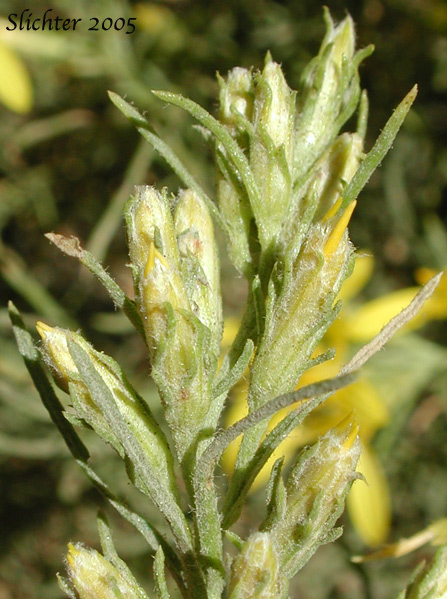 The photo at right shows a close-up view of the narrow involucral bracts of rabbitbrush goldenweed as seen along Road #82 between Roads #190 and #200 at the southeastern corner of Mt. Adams..........August 25, 2005.
The photo at right shows a close-up view of the narrow involucral bracts of rabbitbrush goldenweed as seen along Road #82 between Roads #190 and #200 at the southeastern corner of Mt. Adams..........August 25, 2005.
Rabbitbrush goldenweed is a many-branched shrub from 10-60 cm high. The twigs are brittle with glandular to occasionally sticky and hairy. The numerous leaves are linear to narrowly oblanceolate, ranging from 2-6 cm long and o.5-4 mm wide. The leaves may be straight or twisted.
The inflorescence is clustered at the ends of the twigs but the inflorescence forms an elongate, narrow and often dense cluster. The involucre ranges from 7-11 mm high with narrower and less leafy bracts than Ericameria greenei. The flowers are yellowish with 1-5 ray flowers, the rays ranging from 6-12 mm long) and 4-12 disk flowers which range from 7-11 mm long. Occasionally, the rays may be absent from a flower head.
Greene's Goldenweed Ericameria greenei: Flower heads with ray flowers. Leaf blades generally more oblanceolate or spatulate. Leaves measure 1.5-3.5 cm long and 2-7 mm wide. Inflorescence is short and compact at the end of twigs.
Green Rabbitbrush Ericameria viscidiflora: Flower heads entirely discoid. Leaf margins wavy or twisted. Leaf blades generally linear-filiform to linear or linear-oblong. Leaves vary from 1.5-6 cm long and 0.5-5 mm wide. Inflorescence is short and broad at the ends of the twigs.
Rabbitbrush goldenweed is found on cliffs and in rock crevices. It is especially abundant on the near vertical faces of basalt cliffs. It is a plant of rocky areas within the plains and foothills, but may be found as high as 6000 feet on the east slopes of the Cascade Mountains.
Rabbitbrush goldenweed is found east of the Cascade crest in Washington, Oregon, and into northern California (Modoc County). Its range extends east to the Wallowa Mts. of northeastern Oregon and into the mountains of central Idaho.